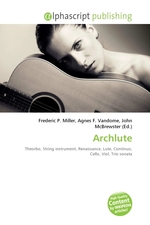Archlute
Frederic P. Miller, Agnes F. Vandome, John McBrewster
бумажная книга
High Quality Content by WIKIPEDIA articles! The archlute is a European plucked string instrument developed around 1600 as a compromise between the very large theorbo, the size and re-entrant tuning of which made for difficulties in the performance of solo music, and the Renaissance tenor lute, which lacked the bass range of the theorbo. Essentially a tenor lute with the theorbo's neck-extension, the archlute lacks the power in the tenor and the bass that the theorbo's large body and typically greater string length provide. The main differences between the archlute and the "baroque" lute of northern Europe are that the baroque lute has 11 to 13 courses, while the archlute typically has 14, and the tuning of the first six courses of the baroque lute outlines a d-minor chord, while the archlute preserves the tuning of the Renaissance lute, with perfect fourths surrounding a third in the middle for the first six. The archlute was often used as a solo instrument for the first three-quarters of the 17th century, but is rarely mentioned as a continuo instrument in this period, the theorbo being the lute class instrument with this role.
Данное издание не является оригинальным. Книга печатается по технологии принт-он-деманд после получения заказа.


